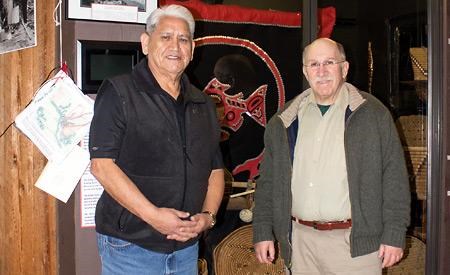With ratification of the Tla’amin (Sliammon) First Nation treaty almost complete, Tla’amin council is working diligently to replace the Indian Act with effective self-governance.
“It has been a long journey for us,” said Chief Clint Williams of the 20 years that his nation has been involved in the BC treaty process.
On Saturday, March 15, officials and dignitaries will gather to witness the treaty being signed by representatives of Canada before it is presented in Parliament in Ottawa. “March 15 marks a significant day in Sliammon history,” he said. “It is a day that will mark the end of a very difficult process and the beginning of a brighter future for the Tla’amin people.”
Part of the transition plan is to deliver an educational program, Educating our Region about Tla’amin First Nation, to the people of Tla’amin and neighbouring communities. Key to the program’s success is the development of an historical, cultural and social toolkit that will provide a meaningful, effective way to engage both aboriginal and non-aboriginal communities to understand the coming changes.
Lawyer and advocate Paul Schachter and Tla’amin council coordinator Marlane Christensen delivered a request to the City of Powell River to become a project partner in the Powell River Diversity Initiative (PRDI) project. Under the partnership, the city, along with School District 47, Vancouver Island University, and Powell River Regional District, has agreed to provide $7,500 in funding to aid in start-up and project delivery. Vancouver Foundation has also been approached for matching funds. PRDI, the lead organization, will administer the grants, hire and supervise employees, and prepare appraisals and reports. The project is expected to run from July 2014 to June 2016.
Schachter also requested that the city consider submitting applications for the Healthy Communities Capacity Building Fund for local governments.
“One of the key aspects of the project,” Schachter said, “is to help people to understand the legal context, the changes and the relationships that will take place with a post-treaty Tla’amin.”
Schachter explained that the process will also serve to encourage elders, community leaders, parents, educators and residents to explore the conditions of the past in relation to the emerging present. “It is difficult to understand what is taking place here without having a firm handle on what has already taken place in our history,” he said. “This initiative will make all of that information accessible.”
Early on, the program organizers realized it was down to the local community to provide education. “When the treaty was initialled,” Schachter said, “the PRDI asked the province, okay, what are you going to do to work in the community and facilitate understanding of the process here? They said we were on our own. Because of the great cooperation between the Tla’amin people and the communities to the south and to the north, we decided we won’t stand on formality. We are going to work with the PRDI to get it done. It is so important to start off with a good foundation.”
Schachter explained that one of the main goals is coordination and cooperation between stakeholders and the respective communities. “We brought the city and the regional district on board and asked that they provide funds to compile historical documents and to aid in delivery of the program to community forums and to educators. We need to search for mutual solutions to problems and to aid in the transition process. One of the ways to do this is to provide a means to educate people, because you can’t solve problems unless you understand the history—what the problems are and where they came from. We need to understand the history and make it accessible.”
Tla’amin councillor Eugene Louie explained that the band council has been working diligently on the treaty process. “It’s been a work in progress for a number of years for our nation,” he said. “We’ve been working with Vancouver Island University to develop due process. Once we get into self-governance we need to understand what types of personnel will be needed to administer the system: what certification and accreditation will be required. We have many people on the finance end and we have good legal counsel. We have many teachers in place, but not all of them are here at home. We have many teachers and doctors that are presently working throughout the province. We are working together with neighbouring governments and with big industry. We have mutual agreements with all of them. We are very aware of the official community plans of all three local governments and that we need to work together to integrate these plans.”
Louie said the good working relationships that have been developed with the city and regional district are the product of years of collaboration and cooperation. He expects this will be vital to assist with seamless transitions as governance is handed over to Tla’amin.
“Marlane Christensen spearheaded the project for us,” Louie said. “We’ve done our comprehensive community planning in terms of where we’re at now. The way we govern ourselves in the future is going to be completely different from what is being done now. Our goal is to develop the tools and the education to have good government.”



